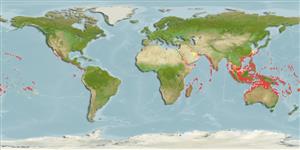Common names from other countries
Environment: milieu / climate zone / depth range / distribution range
Ecologia
marino associati a barriera corallina; distribuzione batimetrica 1 - 73 m (Ref. 89467). Tropical; 30°N - 32°S
Indo-Pacific: East Africa south to Durban, South Africa (Ref. 4919) and east to the Panama, north to Ryukyu Islands, south to Lord Howe and Easter islands. Eastern Pacific: Guaymas, Mexico to Ecuador (Ref. 9349).
Size / Peso / Age
Maturity: Lm ? range ? - ? cm
Max length : 50.0 cm TL maschio/sesso non determinato; (Ref. 9710)
Spine dorsali (totale) : 0; Raggi dorsali molli (totale) : 10 - 12; Spine anali: 0; Raggi anali molli: 11 - 13. Body covered with prickles (Ref. 559).
Occurs in coral-rich areas of clear lagoon and seaward reefs, Ref. 48637. Prefers oceanic localities (Ref. 48637). Solitary (Ref. 90102). Benthopelagic (Ref. 58302). Feeds mainly on tips of branching corals and to a lesser extent on sponges, mollusks, bryozoans, tunicates, forams, algae, and detritus.
Life cycle and mating behavior
Maturities | Riproduzione | Spawnings | Egg(s) | Fecundities | Larve
Myers, R.F., 1991. Micronesian reef fishes. Second Ed. Coral Graphics, Barrigada, Guam. 298 p. (Ref. 1602)
IUCN Red List Status (Ref. 130435)
CITES (Ref. 128078)
Not Evaluated
Threat to humans
Poisonous to eat (Ref. 4690)
Human uses
Pesca: commerciale; Acquario: Commerciale
Strumenti
Special reports
Download XML
Fonti Internet
Estimates based on models
Preferred temperature (Ref.
115969): 24.3 - 29, mean 27.8 (based on 1320 cells).
Phylogenetic diversity index (Ref.
82804): PD
50 = 0.5000 [Uniqueness, from 0.5 = low to 2.0 = high].
Bayesian length-weight: a=0.03715 (0.01569 - 0.08798), b=2.87 (2.70 - 3.04), in cm Total Length, based on LWR estimates for this Genus-body shape (Ref.
93245).
Trophic level (Ref.
69278): 3.6 ±0.0 se; based on diet studies.
Resilienza (Ref.
120179): Medio, tempo minimo di raddoppiamento della popolazione 1.4 - 4.4 anni (Preliminary K or Fecundity.).
Fishing Vulnerability (Ref.
59153): Moderate vulnerability (40 of 100).
